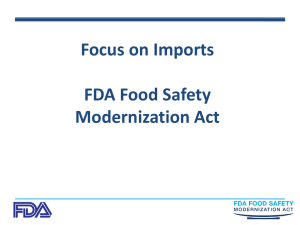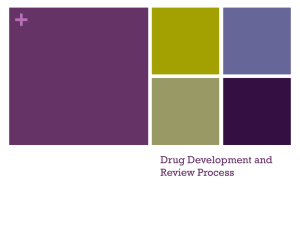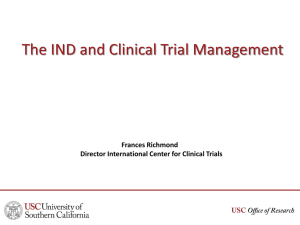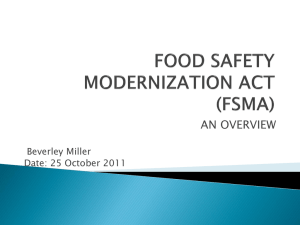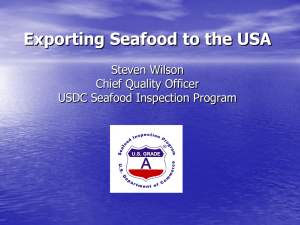Foods - AHEI - American-Hellenic Chamber of Commerce
advertisement
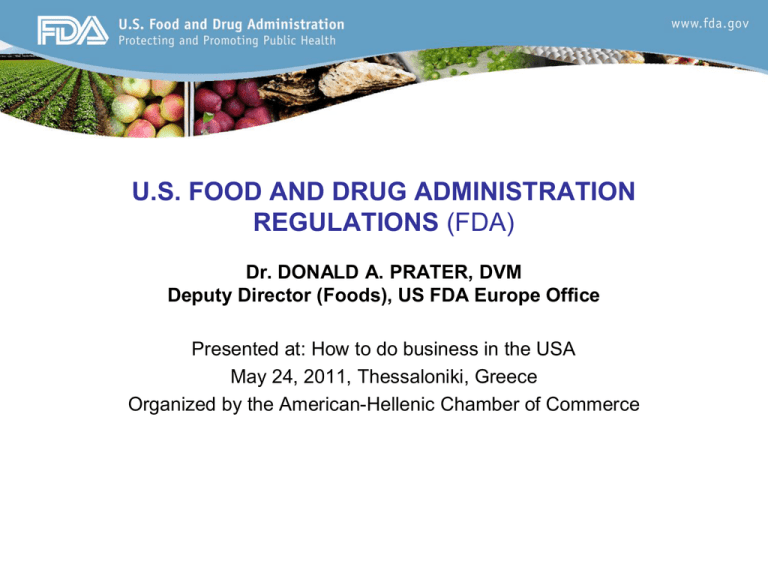
U.S. FOOD AND DRUG ADMINISTRATION REGULATIONS (FDA) Dr. DONALD A. PRATER, DVM Deputy Director (Foods), US FDA Europe Office Presented at: How to do business in the USA May 24, 2011, Thessaloniki, Greece Organized by the American-Hellenic Chamber of Commerce FDA’s Mission • Protect public health by assuring the safety and efficacy of – – – – – human drugs biological products medical devices and products that emit radiation animal feed and veterinary drugs food and cosmetics • Advance public health by facilitating innovations that make medicines and foods more effective, safer and more affordable • Provide the public with accurate, science-based information on medicines and foods Challenges of Globalization Globalization has fundamentally changed the environment for regulating food and medical products and has created unique regulatory challenges for FDA: – More foreign facilities supplying the U.S. – Increasing volume of FDA-regulated imported products – $2 Trillion worth of products enters the U.S. from more than 150 countries, with 130,000 importers of record, and from more than 300,000 foreign facilities 3 4 Number of Foreign Sites Making FDA-Regulated Drugs Has More Than Doubled Since 2001 Official FDA Data – ORA/DIOP 3,000 Foreign Facilities 2,820 Foreign Facilities Inspections 2,595 Number of Active Sites 2,500 2,323 2,046 2,000 1,780 1,507 1,500 1,282 1,000 500 249 211 189 260 255 212 325 0 CY01 CY02 CY03 CY04 CY05 Note: Number of foreign facilities inspections are scaled in fiscal year. Calendar Year Number of foreign facilities are scaled in calendar year. Numbers approximate due to data limitations. CY06 CY07 5 FDA Foreign Offices 6 6 U.S. Food Safety System Department of Health and Human Services (HHS) – Food and Drug Administration (FDA) – Centers for Disease Control and Prevention (CDC) Department of Agriculture (USDA) – Food Safety and Inspection Service (FSIS) – Animal and Plant Health Inspection Service (APHIS) – Foreign Agricultural Service (FAS) Environmental Protection Agency (EPA) Department of Commerce – (NOAA NMFS) Bureau of Customs and Border Protection (CBP) Alcohol and Tobacco Tax and Trade Bureau (TTB) State and local health and agricultural agencies Bioterrorism Act Regulations • Took effect December 12, 2003 • FDA and Border Patrol/Customs collaboration • Facility Registration (foreign 226,373; total 382,866) – Domestic and foreign facilities engaged in manufacturing, processing, packing and holding of food – Greece has 1,166 registered facilities – The EU has 54,181 registered facilities • Prior Notification of imported foods – 2 hours by land – 4 hours by air or by rail – 8 hours by sea Major FDA Center for Food Safety and Applied Nutrition (CFSAN) Programs - Food facility registration and prior notice for imports – Minimization of health risks due to chemical and biological contamination – Safety of dietary supplements, infant formulas and medical foods – Pre-market safety of substances added to food, including colors – Safety of food and ingredients developed through biotechnology Major CFSAN Programs – Food and allergen labeling, health claims – Seafood and juice HACCP regulatory programs – Low Acid Canned Food/Acidified Food (LACF) process registration – Post-market surveillance and compliance – International food standard and safety harmonization (Codex, WTO) – Technical cooperation and assistance Reportable Food Registry • Portal opened September 2009 • All registered food facilities (domestic and foreign) required to report in 24 hours • When there is reasonable probability that food or feed will produce serious adverse health consequences to humans or animals (equivalent to Type 1 Recall) • Served by HHS Safety Reporting Portal Food Defense Approach • Detect and identify harmful organisms and toxins in food (Awareness) • Train industry and state officials on “CARVER” vulnerability assessments (Prevention) – – – – – – Criticality Accessibility Recuperability Vulnerability Effect Reconcilability • Develop effective strategies to protect the food supply from terrorist threats (Protection) • ALERT, FIRST How to Export Food to the U.S. • Register facility with FDA • Register process for canning/aseptic packaging of Low Acid/Acidified Canned Foods (LACF) • Give “Prior Notice” • Use good practices in food production – Agricultural – Aquacultural – Manufacturing – HACCP • Assure that the product is safe, wholesome, sanitary, properly packaged and labeled FDA Food Safety Modernization Act Main Themes of the Legislation Prevention Standards Inspections, Compliance, and Response Enhanced Partnerships Import Safety Import Safety: Most groundbreaking shift • Current reliance on port-of-entry inspection cannot handle increase in imported food. • Importers now responsible for ensuring that their foreign suppliers have adequate preventive controls in place • Requires food from abroad to be as safe as domestic Import Safety Mandates Sec. 301. Foreign supplier verification program • Requires importers to verify their suppliers use risk-based preventive controls that provide same level of protection as U.S. requirements. Sec. 302. Voluntary qualified importer program • Allows for expedited review and entry; facility certification required Sec. 303. Certification for high-risk food imports • FDA has discretionary authority to require assurances of compliance for high-risk foods Import Safety Mandates Sec. 304. Prior notice of imported food shipments • Requires information on prior refusals to be added to prior notice submission Sec. 305. Capacity building • FDA mandate to work with foreign governments to build food safety capacity Sec. 306. Inspection of foreign food facilities • Can deny entry if FDA access for inspection is denied Sec. 201. Targeting of inspection resources • Increased inspection of foreign as well as domestic facilities Import Safety Mandates Sec. 307. Accreditation of third-party auditors • FDA can rely on accredited third parties to certify that foreign food facilities meet U.S. requirements Sec. 308. Foreign Offices of the Food and Drug Administration. • Establish offices in foreign countries to provide assistance on food safety measures for food exported to the U.S. Sec. 309. Smuggled Food • In coordination with DHS, better identify and prevent entry of smuggled food Role of Third-Party Certification Programs • Tool for importers to obtain needed assurances to meet their obligations for the foreign supplier verification program (sec. 301) • A way for importers to participate in the voluntary qualified importer program to expedite movement of food through the import process (sec. 302) • Can be required by FDA to accompany high-risk foods (sec. 303) Import Projects Completed (as of May 2011) Sec. 304. Prior notice of imported food shipments – Requires information on prior refusals to be added to prior notice submission – Effective July 3, 2011 Enhanced Partnerships: Vital to Success International capacity building – FDA has mandate to work with foreign governments to build their food safety capacity – Allows FDA to rely more heavily on foreign government oversight – Capacity building helps to prevent problems before products reach the U.S. port of entry. Implementation: FDA is prepared • • • • Experience in preventive controls Implementation process in place Much work already underway Projects completed can be found on www.fda.gov/fsma But, many challenges • Enormous workload - 50 new rules, guidance documents, reports in 3 years • Tight deadlines • Changes won’t appear overnight - Building new system will be a long-range process • Resources Implementation Approach • • • • Coalition needed Transparency a priority Focus on public health protection Engage with stakeholders to help determine reasonable and practical ways to do so Priorities • Prevention – Mandatory preventive controls for facilities (FR 18 months) – Produce safety standards (FR 2 years) – Intentional contamination (FR 18 months) • Inspection, Compliance, and Response – Administrative detention (IFR 120 days) – Recall (Upon enactment) – Suspension of registration (180 days) • Imports – Foreign supplier verification program (Guidance and FR 1 year) – Accredited third-party certification program (FR 2 years) – Mandatory certification for high risk foods (Upon enactment) For more information www.fda.gov/fsma (Subscription feature available) Contact Information Donald A. Prater, DVM Deputy Director (Foods) FDA Europe Office Based at the European Food Safety Authority Parma, Italy Telephone: 39 0521 036582 Email: donald.prater@fda.hhs.gov



